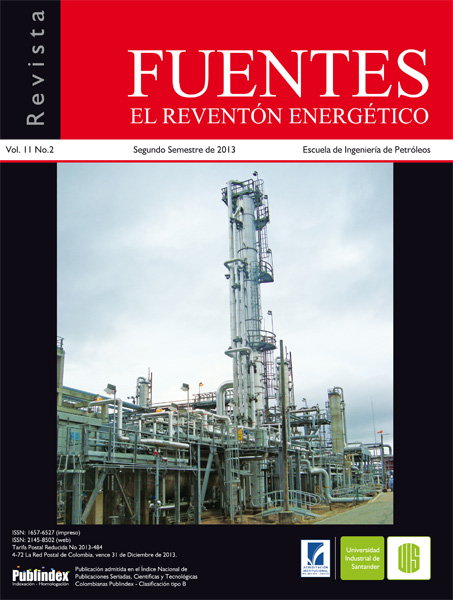Enhanced oil recovery by air injection in colombia: selection process and technical evaluation
Published 2013-12-23
Keywords
- Air injection,
- binary screening,
- analogies,
- experimental evaluation,
- experimental design
- numerical simulation ...More
How to Cite
Abstract
Considering the Colombian needs to incorporate reserves, enhanced oil recovery methods are proposed as suitable alternatives to implement in the existing fields. However, depending on each field characteristics and the application conditions of each process may consider implementing it.
The air injection is an enhanced oil recovery method which maximizes recovery factor, nevertheless, the technical and economical requirements for its implementation make necessary to evaluate its possible application properly. Therefore, it is necessary to establish a selection process that includes: semi-analytical analysis with methods of binary screening and analogies, experimental evaluation from specialized laboratory tests, analytical study for making the preliminary production approach and finally numerical simulation.
This article shows the selection process of the air injection as enhanced oil recovery method in a Colombian field, describing each of the steps used for its selection and the importance of securing each step due to the complexity of air injection application in the field.
Downloads
References
2. SaRaTHi, P. in-Situ Combustion Handbook Principles and Practices. National Petroleum Technology Office: Tulsa, OK, 1999; Report DOE/PC/91008-0374, OSTi iD 3174.
3. MORTEn, R. K. Development of Models and Algorithms for the Study of Re-active Porous Media Processes. Technical university of Denmark, Department of Chemical and Biochemical Engineering, Frydenberg A/S, Copenhagen, Den- mark, 2008.
4. Software ECOEOR. Producto tecnológico Instituto Colombiano del Petróleo. 2011.
5. TRuJiLLO, Marta, RODRiGuEZ, Edwin y DELGADILLO, Claudia. Metodología para predecir el desempeño de procesos de inyección de aire mediante simulación numérica. Producto tecnológico Instituto Colombia del Petróleo, ECOPETROL S.a., Piedecuesta, 2011.
6. BELGRAVE, J. D. y MOORE, R. G. A model for improved analysis of in situ combustion tube test. Journal of Petroleum Science and engineering. 1992, Vol 8.
7. ORDOÑEZ, aníbal, TRuJiLLO, Marta y RODRÍGUEZ, Edwin. ECO-GSAI “Gravity srable air injection” pilot test, an enhanced oil recovery opportunity to be implemented in Chichimene field – Colombia. SPE 154255, Oklahoma USA, 2012.
8. nELSOn, T. W y MCnEiL, J.S. How to engineer an in Situ Combustion Project. The Oil and Gas Journal. June 5, 1961.
9. Ga TES, C. f., RaMEY, H. J. Jr. field Result Of South Belridge Thermal Recovery Experiment. Trans, aiME. P 213-236
